Just like clothes, makeup, skincare and TikTok dance videos, food and desserts get their fair share of trends as well. People would now and then discover the latest dessert trends around the world such as new desserts at their local pastry shops, new ways of eating certain foods, and new ways of cooking certain traditional cuisines. People are sharing everything on social media now and the luckier desserts that get trended will make it to the best desserts around the world list.
Here are some of the latest dessert trends around the world in 2023:
- Escapist Indulgent Moments: Desserts are about indulgence, and there’s a trend towards more colourful, global flavours and super sweet nostalgia with a twist. For example, ube creams from the Philippines, matcha from Japan, and black sesame from China are all trending flavours. There’s also a movement towards savoury notes in desserts, such as adding umami flavours from ingredients like miso, seaweed, and tomatoes.
- Plant-based desserts: Plant-based diets are becoming increasingly popular, and this is reflected in the dessert world. There are now many delicious and innovative plant-based desserts available, made with ingredients like nuts, seeds, fruits, and vegetables.
- Customizable desserts: People are looking for more personalized experiences, and this is also true of desserts. There is a growing trend towards customizable desserts, where customers can choose their own flavours, toppings, and textures. This allows people to create the perfect dessert for their own taste.
- Artisanal desserts: There is a renewed interest in artisanal desserts, made with high-quality ingredients and traditional methods. These desserts are often more expensive, but they offer a unique and authentic experience.
- Micro-desserts: Micro-desserts are small, bite-sized desserts that are perfect for sharing. They are often made with delicate flavours and textures, and they can be a fun and elegant way to end a meal.
- Dessert cocktails: Dessert cocktails are a delicious and refreshing way to end a meal. They often combine traditional dessert flavours with alcohol, such as chocolate martinis and mojitos with berries.
Despite the above, there are some classics that can never go out of trend such as Asian egg tarts, Malaysian kuihs, Japanese mochi, Italian Tiramisu, French macaroon, and American brownies, just to name a few must-try desserts around the world.
When it’s time for you to start packing for that Euro trip or month-long vacation to South America, be sure to bring along this international desserts guide. Modern or traditional, these top desserts worldwide will not disappoint.
Speaking of must-try desserts around the world, serve your sweet tooth with some of our best picks, starting closer to our own home in Malaysia.
Popular Desserts Around The World
MUST-TRY Malaysian Desserts
Ais Kacang
Ais Kacang literally means ‘ice’ and ‘beans’, or beans on ice. It’s a sweet yet refreshing shaved ice dessert that’s topped with kidney beans, nuts, jellies and syrups. They’re all of different colours so Ais Kacang is a colourful dessert that puts a smile on every Malaysian’s face.
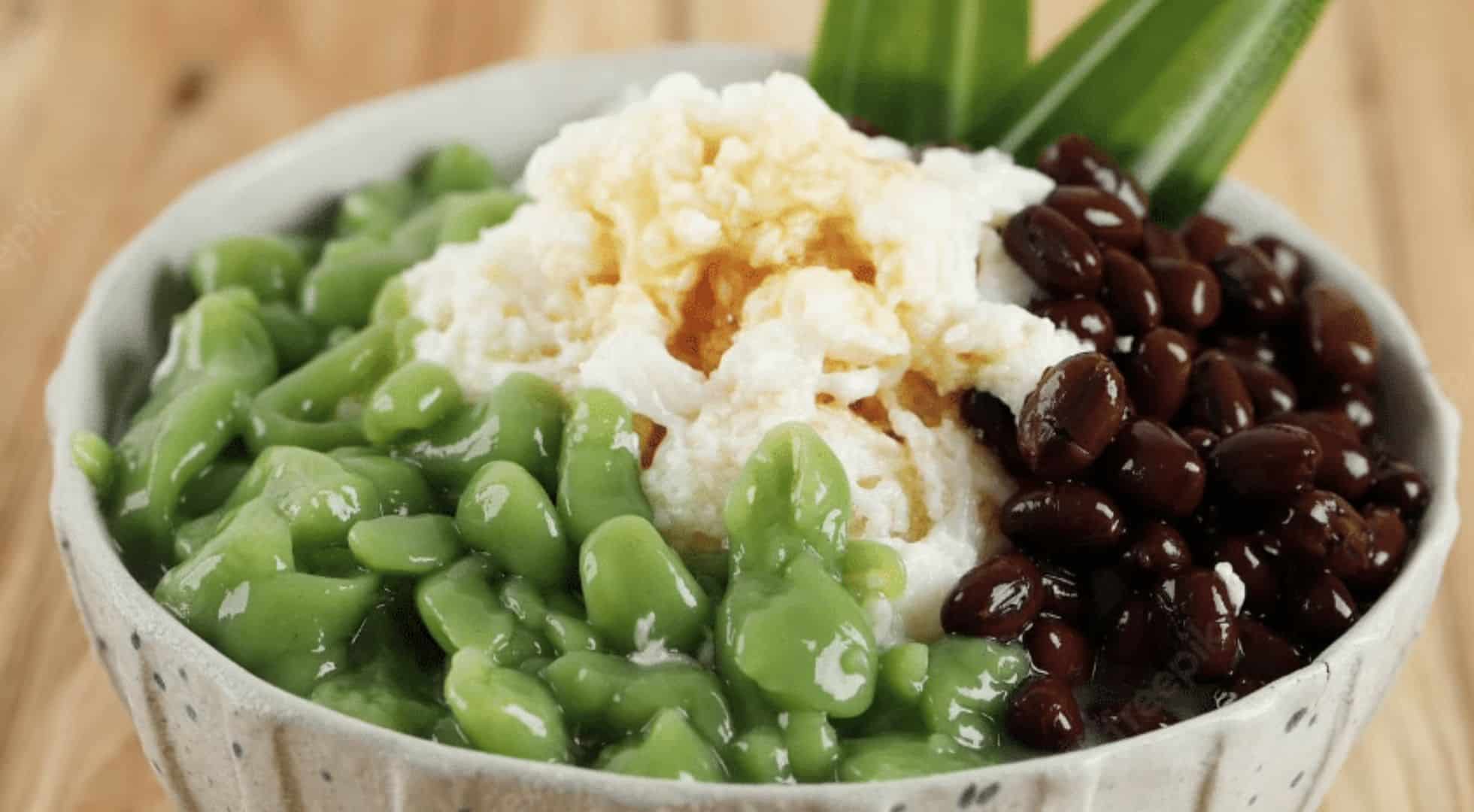
Cendol
Similar to Ais Kacang, Cendol has very specific ingredients on shaved ice like coconut milk, palm sugar syrup – also known locally as gula Melaka – and green rice flour jelly noodles.
Bubur Cha Cha
Fun fact: The name “Bubur Cha Cha” means “mixed porridge” in Malay.
This sweet dessert is believed to have originated in the Peranakan community in Malaysia and Singapore. It can be served warm or cold and is made heavily with coconut milk. There are other ingredients as well such as sago pearls, yams, purple sweet potatoes, grated coconut, coconut cream, bananas and pandan leaves. Some Malaysians love eating it for breakfast instead.
Tang Yuan
Tangyuan is a traditional Chinese dessert that originated in southern China. It is made of glutinous rice flour and is often filled with sweet or savoury fillings. Tangyuan is traditionally eaten during the Lantern Festival, which falls on the 15th day of the first lunar month, but it can also be eaten at other times of the year. Over the centuries, it has spread out throughout East Asia and Southeast Asia, but Malaysians would sometimes make it all year round to serve it as dessert. In states like Kuala Lumpur and Penang, you can find stalls and stores selling Tang Yuan all year round.
Sago Gula Melaka
This dessert is made mainly of palm sugar syrup or what we call, gula Melaka. It’s a pudding made with sago pearls and coconut milk. Pandan leaves are often added for their aroma and flavour.
Pisang Goreng
Pisang goreng, a Malaysian-style deep-fried banana fritter, is a must-try. The bananas are made with saba bananas that are coated in a batter of rice flour, cornstarch, and water, and then deep-fried.
Muah Chee
Muah chee is a Chinese dessert that is popular in Malaysia, Singapore, and Indonesia. It is made with glutinous rice flour, which is steamed until it forms a dough. The dough is then cut into small pieces and coated with peanut powder, sugar, and toasted sesame seeds.
Kuih Bahulu
Kuih bahulu is a type of mini egg sponge cake that is popular in Malaysia, Singapore, and Indonesia. It is made with eggs, sugar, flour, and baking powder. The cakes are typically baked in small moulds, which gives them their characteristic shape.
Kuih bahulu is often made during the festive seasons of Hari Raya Puasa (Eid al-Fitr) and Chinese New Year. It is also a popular snack or dessert.
The cakes have a crusty exterior and a soft, slightly sweet interior. They are not too sweet, making them suitable for children. Some Malaysians also enjoy dunking the cakes in coffee or Milo. There are different variations of kuih bahulu, including bahulu cermai (star-shaped), bahulu gulung (rolled), and bahulu lapis (layered).
Tau Sar Piah
A Penang signature, Tau Sar Piah also known as Tambun biscuits, is a savoury-sweet mung bean-filled snack housed in a buttery, flaky pastry. It can be eaten any time of the day with tea or coffee, and must always be brought back with you when your vacation on the island ends.
Kek Lapis Sarawak
Kek Lapis Sarawak, also known as Sarawak layer cake, is a delicious and intricate cake that is made in the Malaysian state of Sarawak. It is made with alternating layers of sponge cake that are coloured with natural food colouring and filled with a variety of spices. The layers are then stacked and rolled together to create a beautiful and colourful cake.
Kek Lapis Sarawak is a labour-intensive cake to make, and it can take several hours to complete. Each layer of the cake must be baked individually to ensure that it is cooked perfectly. The layers are then assembled using a rolling machine, which helps to create smooth and even layers.
Kek Lapis Sarawak is traditionally served at special occasions and festivals, such as Eid ul-Fitr, Deepavali, and Gawai. It is also a popular souvenir to bring back from Sarawak.
Kuih Seri Muka
This double-layered Malaysian dessert is made with glutinous rice, coconut milk, and pandan. You’ll find glutinous rice steamed with coconut milk at the bottom layer while the top gets layered with custard. The green colouring and flavour you see is made from pandan juice.
Seri Muka is a delicious and refreshing dessert that is often served at special occasions, such as weddings and festivals. It is also a popular snack or dessert that can be enjoyed at any time of the day.
Leng Chee Kang
Leng Chee Kang is a traditional Malaysian dessert that is made with lotus seeds, ginkgo nuts, longans, sweet potatoes, and grass jelly. It is a sweet and refreshing dessert that is often served warm or cold. The ingredients can be adjusted to your liking, and other ingredients that can be added include beans, jelly, and nuts. The syrup is typically sweetened with rock sugar, but other sweeteners can be used as well.
Leng Chee Kang is a popular dessert among the Chinese community in Malaysia, and it is often served at special occasions, such as weddings and festivals. It is also a popular snack or dessert that can be enjoyed at any time of the day.
Red Bean Soup
Also, a Chinese community favourite, this dessert is made with red beans that are boiled in water and sweetened with rock sugar. Most Malaysians will add tangerine peels and pandan leaves to give it a more aromatic taste. The tangerine peels add a citrusy flavour to the soup, while the pandan leaves add a subtle sweetness and aroma.
The red beans are typically soaked overnight before boiling to soften them. The soup is then simmered for several hours until the red beans are soft and the flavours have blended together.
Red bean soup is a delicious and nutritious dessert that is often served on special occasions, such as weddings and festivals. It is also a popular snack or dessert that can be enjoyed at any time of the day.
Tau Fu Fah
Tau fu fah (also known as douhua) is a popular Malaysian dessert that is made with soybeans. It is a light and refreshing dessert that can be eaten as is or flavoured with sugar syrup, palm sugar syrup, or ginger syrup. Tau fu fah can be enjoyed warm or chilled. For the cold version, adding longan would be perfect.
Tau fu fah is made by coagulating soy milk with a coagulant, such as gypsum or nigari. The resulting tofu is then cut into cubes and served with a variety of toppings, such as sugar syrup, palm sugar syrup, ginger syrup, longan, and red beans.
Tau fu fah is a good source of protein and calcium. It is also a low-fat and low-calorie dessert, making it a healthy option for those watching their weight.
Asian and South Asian Desserts
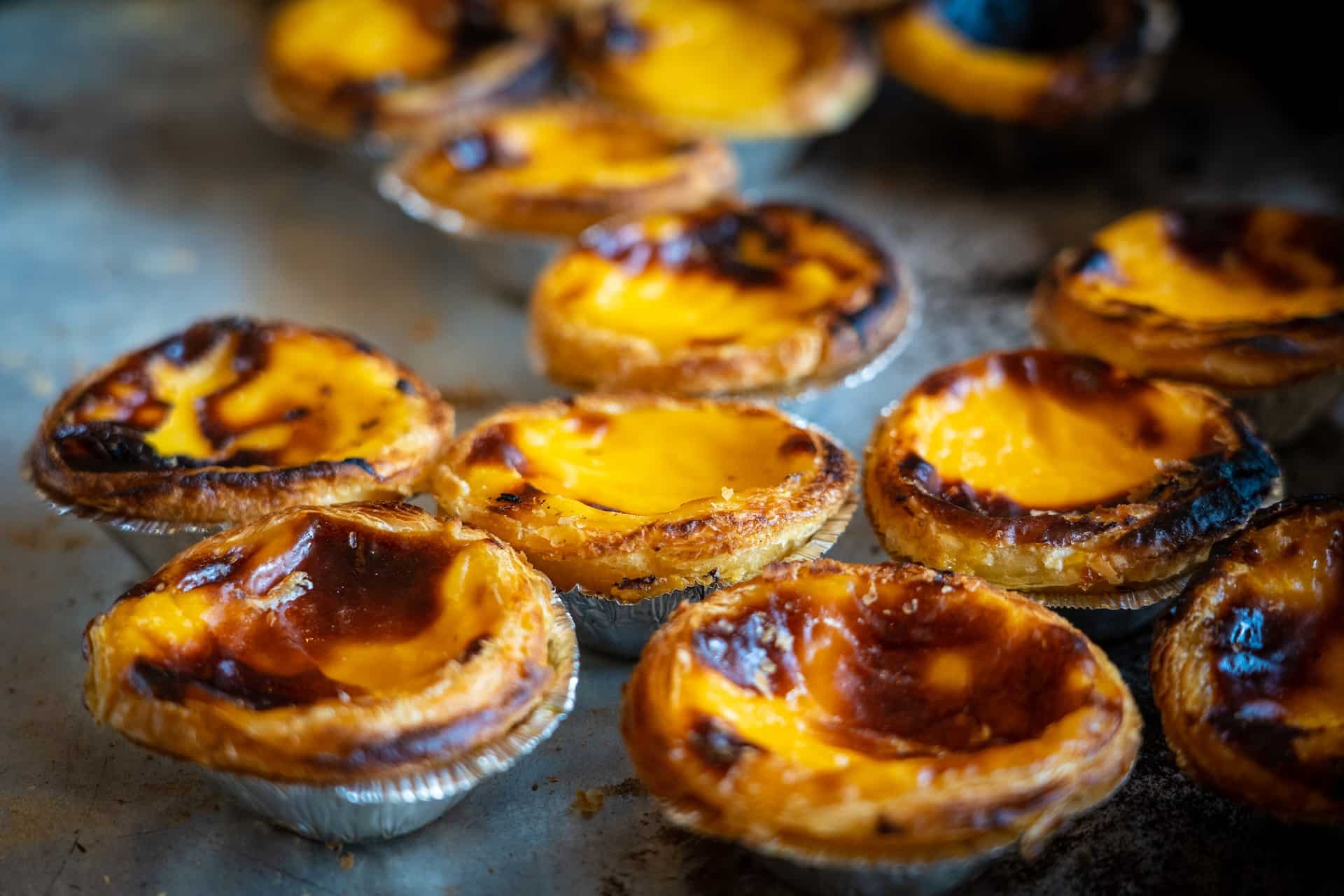


Hong Kong
Egg Tarts
The Hong Kong Egg Tarts have become so popular that you can find them all over Southeast Asia, as well as Asian countries outside of China. They’re made small, and perfect for eating when you’re on the go, as Hongkongers are always in the rush. These creamy egg tarts are best eaten fresh from the oven when the custard is still warm and the crust is still flaky and soft.
Not to be confused with the pastéis de nata of Portugal – or simply called Portuguese tarts – the Hong Kong Egg Tarts are smaller in size and the custard is made from a different recipe as compared to our Portuguese counterpart. Given the history between Hong Kong and Portugal, the Portuguese egg tart is fairly famous in Hong Kong too.
India
Gulab Jamun
The name “gulab jamun” comes from the Persian words “gulab” (rose) and “jamun” (plum). The dessert is believed to have originated in the Middle East and was brought to India by the Mughals.
Gulab jamun is a popular Indian dessert that is made with milk solids (khoya), sugar and rose water. It is a deep-fried dessert that is then soaked in sweet syrup. Gulab jamun is often served as a dessert after a meal, but it can also be eaten as a snack. The recipe starts with a scoop of khoya – a reduction of cow or buffalo milk that simmers for hours over a low flame until the texture becomes a paste. Then, it’s fried in ghee before being soaked in an aromatic syrup infused with cardamom seeds and roses.
Kulfi
Served frozen, Kulfi is a frozen dessert with a rich texture that comes from the ice cream family. It requires hours of constant stirring. The chef will start by simmering fresh milk over a low flame. This process gives a caramel sweetness to the milk’s natural sugars. Kulfi is often served in small cups or bowls and can be flavoured with a variety of spices, such as rose, cardamom, saffron, and pistachio.
Thailand
Sticky Rice with Mango
The most important part of this dish is to use mangoes that are just ripe and tender. This traditional Thai dessert starts with the glutinous rice that’s grown in paddies across Southeast Asia. It’s then combined with fresh, rich coconut milk and palm sugar, which is usually poured all over the entire dish. You can find this sticky rice with mango all over South East Asia but if you visit anywhere in Thailand, you got to have this for dessert.
Tub Tim Krob
Translating to ‘crispy rubies’, Tub Tim Krob comes in a colourful exterior but refreshing flavours. The Thais love to have this for dessert right after a fiery meal, as the crushed ice that’s infused with pandan and sweetened coconut liquid can cool down your tongue.
Other ingredients in Tub Tim Krob include water chestnuts that are soaked in vivid grenadine syrup, rolled in tapioca flour, and then boiled. It will then have a chewy and slightly crunchy texture, with a hint of saltiness from the coconut broth.
Taiwan
Douhua or Tofu Pudding
This Taiwanese dessert is made with silken tofu, and its soft texture is perfect for a hot day, or could even be served warm on a cold night. It’s originally an ancient Chinese dish that’s widely consumed in countries like Hong Kong, the Philippines, Vietnam, and Singapore.
Aiyu Jelly
The Taiwanese Aiyu Jelly is made from the seeds of the aiyu fig. This plant is native to Taiwan and some parts of southeastern China. The seeds of the aiyu fig contain a gel-forming substance that is called aiyu mucilage. When the seeds are rubbed with water, the aiyu mucilage is released and forms a yellowish gel. This gel can be set into a jelly form by cooling it in the refrigerator.
Aiyu jelly is a refreshing and delicious dessert that is often served with syrup, fruit, and nuts. It is also a good source of dietary fibre.
Japan
Matcha Swiss Roll
The Japanese are all about their matcha and this fluffy sponge cake is rolled up with fresh matcha cream in the middle. If you love anything matcha, then you should look for this matcha Swiss roll in any Japanese bakery.
Japanese Cheesecake
If you have a soft spot for cheesecakes, then you should not miss out on this Japanese version. It’s made creamier than its New York counterpart, while the light sponge cake gives you a light and airy texture.
Japanese bakers use a special technique of blending beaten egg whites into a warm cream cheese and vanilla batter before baking. When in Japan, be sure to look out for this jiggly dessert.
Warabi Mochi
The Japanese Warabi Mochi is a chilled, chewy, jelly-like mochi that is usually covered with sweet and nutty soybean powder. It’s then finished with Kuromitsu syrup.
Kuromitsu is a Japanese sugar syrup that’s made from unrefined Kokutō and is thinner and milder as compared to molasses.
China
Mung bean cakes
Mung bean cakes, also known as douhuagao or doushabao, are a variety of traditional Chinese desserts that are made with mung beans, sugar, and water. They are typically served during the summer months because they are a refreshing and cooling dessert.
Mung bean cakes are similar in appearance to mooncakes, but they are not exactly the same. Mooncakes are typically made with lotus seed paste and are filled with a variety of fillings, such as red bean paste, lotus seed paste, or egg yolk. Mung bean cakes, on the other hand, are made with a puree of mung beans and do not have any fillings.
Mung bean cakes are a popular dessert in China and can be found in many Chinese restaurants and cafes. They are also a popular dessert to make at home.
Fried Milk
Yes, you heard that right, fried milk is a thing in China and it’s a delicious dessert and snack. The milk is first combined with cornstarch to give it a thick and pudding-like consistency. It’s then placed in the refrigerator to set, before being rolled in breadcrumbs and deep fried.
The outcome is a crispy outside that’s also sweet when bitten into it. The Chinese like having it as an afternoon snack, or an after-dinner dessert.
Philippines
Halo-Halo
The Halo-Halo is the most popular dessert in The Philippines. It comes in a tall cocktail glass and is filled with shaved ice and milk. Then you will see a layer of sweetened bananas, taro, sweet potatoes, mung beans, jackfruit, jelly, corn kernels, coconut, and tapioca pearls. It’s then finished with custard, purple yam jam, and ice cream on top.
The name “halo-halo” means “mix-mix” in Tagalog, and that is exactly what you do with this dessert. You are given a long spoon to mix all the ingredients together until they are well combined. The result is a delicious and refreshing dessert that is perfect for a hot day.
European Desserts
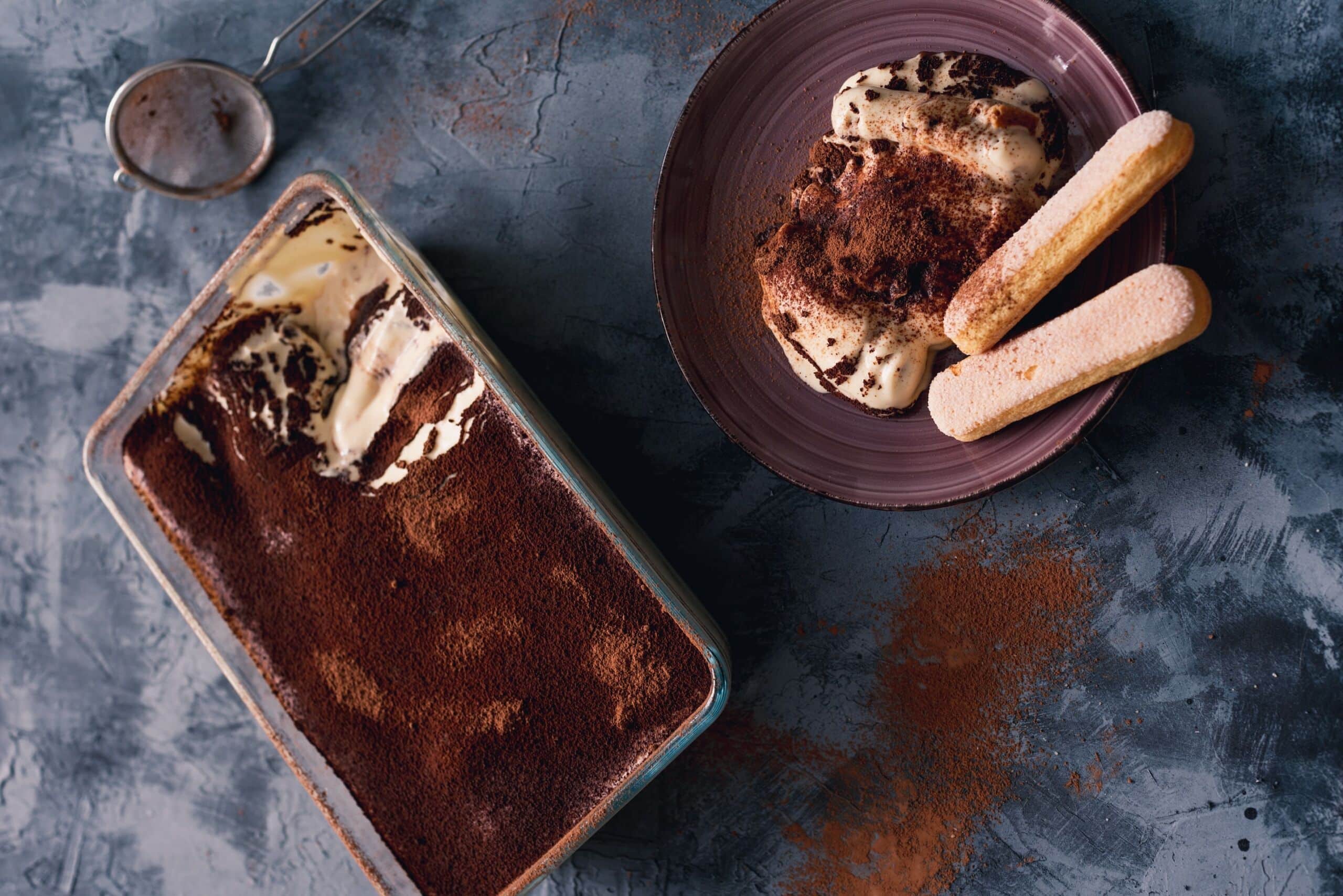


Italy & Sicily
Tiramisú
Tiramisú is made with creamy layers of whipped mascarpone, chocolate, espresso-soaked ladyfingers and Bailey’s. It has a rich and sweet taste that Italians love right after a heavy meal. Also means ‘pick me up’ in English, the Tiramisú can be found all over the world but the best still comes from its motherland.
There are many different variations of tiramisu, but the most common ingredients are:
- Mascarpone cheese: This is a soft, creamy cheese that is essential for the rich and decadent flavour of tiramisu.
- Ladyfingers: These are small, sponge cakes that are soaked in coffee to give the dessert its signature flavour.
- Cocoa powder: This is used to dust the top of the tiramisu and give it a rich chocolate flavour.
Cannoli
This classic Sicilian dessert is made with crisp shells with open ends, allowing the creamy cheese filling to exit freely. Originating from the wild Carnival celebrations at Palermo, the Cannoli’s filling is made with silky-smooth ricotta cheese that comes from sheep’s milk. The pastry shells for cannoli are made with flour, sugar, eggs, and water. They are then fried until they are golden brown and crispy. The shells are then filled with the ricotta cheese filling and served immediately.
France
Chocolate Mousse
The chocolate mousse is light and very airy, making it perfect for those who prefer something light for dessert. The word mousse also means ‘foam’ in English and is made with just a handful of ingredients like chocolate powder, sugar and the like. French pastry chefs have been whipping up chocolate mousse for a few centuries now and is still loved by many today.
Austria
Apfelstrudel
Easier known as Apple Strudel, this traditional dessert is stretched instead of rolled into a very thin sheet. This delicate dough is then used to wrap the sweet, apple filling that’s cooked with buttery fried breadcrumbs, raisins and walnuts. For the best Austrian Apfelstrudel, head over to the bakeries in Vienna.
Hungary
Eszterhazy Torta
The Eszterhazy Torta cake dessert was derived from the Austro-Hungarian Empire days. It then spread across central Europe, especially from Vienna to Sarajevo. The cake is topped with a very thick layer of delicious buttercream and finished with a traditional pattern of marbled spiderwebs of chocolate and vanilla fondant. The sides are then finished with almond meringue for that crunchiness.
Middle Eastern and Turkish Desserts
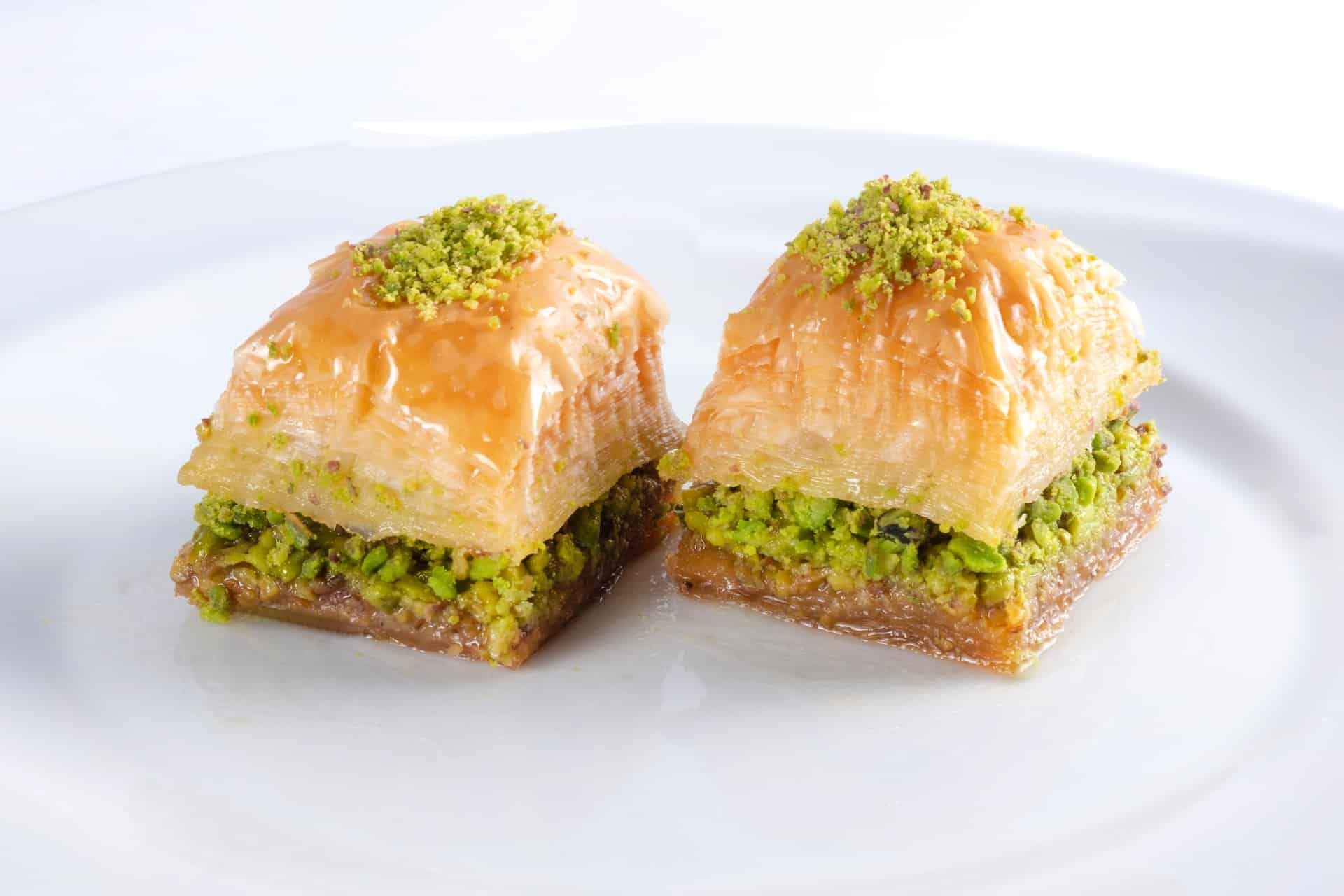


Turkey
Baklava
This dessert is made with dozens of delicate layers and drenched with a special syrup. The Baklava derived from the Ottoman Empire and quickly spread to the Levant, the Balkans, the Caucasus and North Africa. It’s best when eaten after a savoury meal, but some Turks love it as an afternoon snack.
Borma
The Turkish Borma is a sweet dessert with rich nut filling, wrapped with threads of crisp, golden knafeh dough. It’s then fried in oil to add that extra infusion of flavour, plus the crisp texture will make it all even better. Before serving, the Borma would be bathed in a sugary and flavoured syrup to give it that extra kick.
Middle East
Ma’amoul
Ma’amoul is a type of Middle Eastern cookie with thick fillings like ground dates and nuts but also has a thin, soft crust on the outside. These cookies are shaped in wooden moulds – think mooncakes – that are carved with intricate patterns. These cookies are usually consumed during festive seasons.
Qatayef
Qatayef is made with a kind of yeasted pancake batter but is only griddled on one side. That creates a balance between the golden-fried crust and tender interior. As for the folded base, it has a sweet mixture of fresh cheese, dried fruits, nuts and cream, and is finished with scented rose water or ground cinnamon.
Moroccan and African Desserts
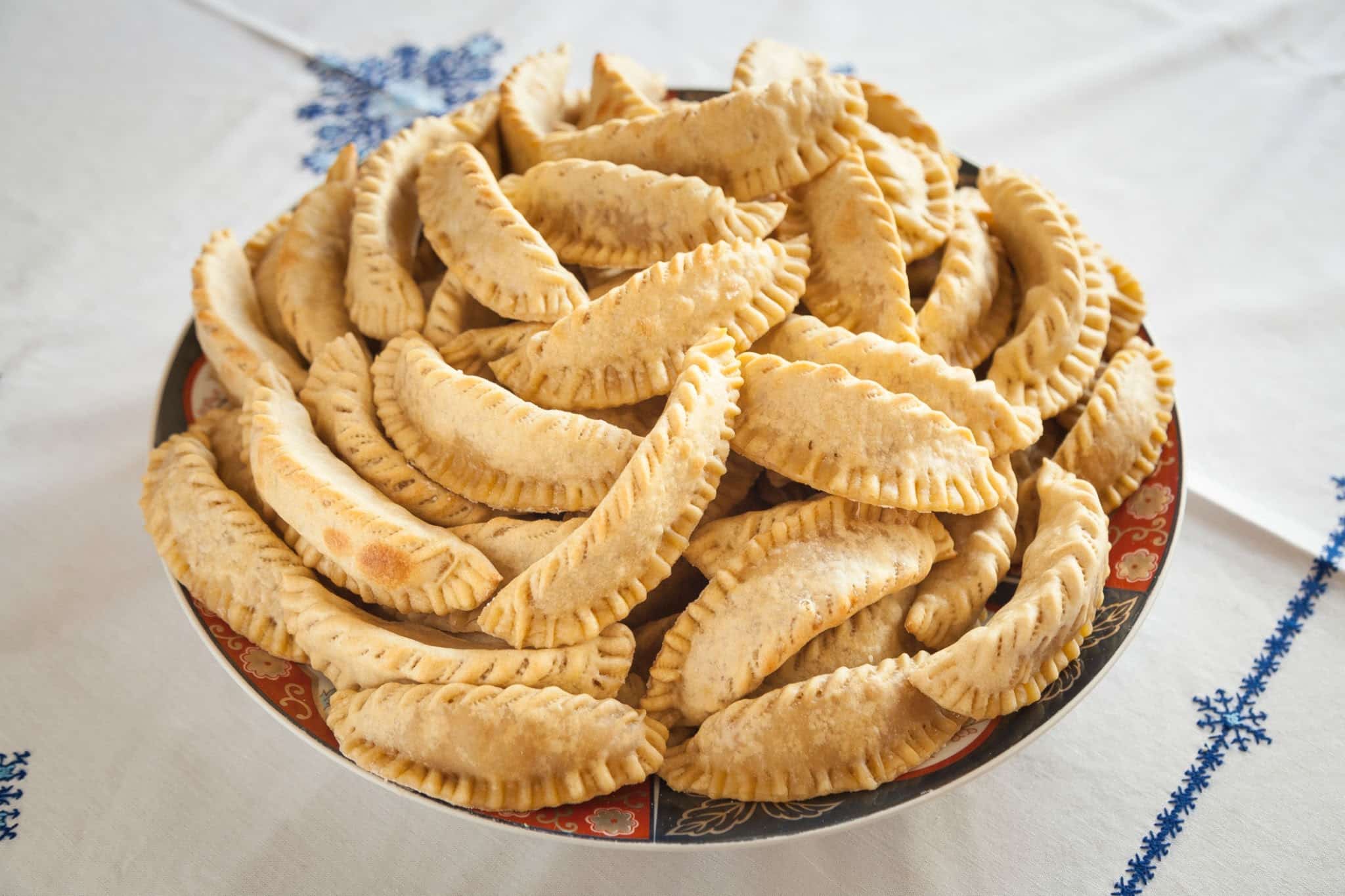


Morocco
Cornes de Gazelle
Morocco is filled with desserts and sweets, but the Cornes de Gazelle still stands out. It is only consumed during festive days as it is very labour-intensive. To make the Cornes de Gazelle, first, a thin layer of dough will curve around a filling of ground almonds soaked with orange blossom water. It will then be baked just until they’re lightly golden, so the dough retains a tender texture that can later melt into the centre.
East Africa
Kashata
The Kashata sweet is made by blending caramelized sugar with the rich heft of peanuts and fresh coconut. The finished product has a crunch on the exterior, making it a great dessert with coffee or tea.
South and Latin American desserts
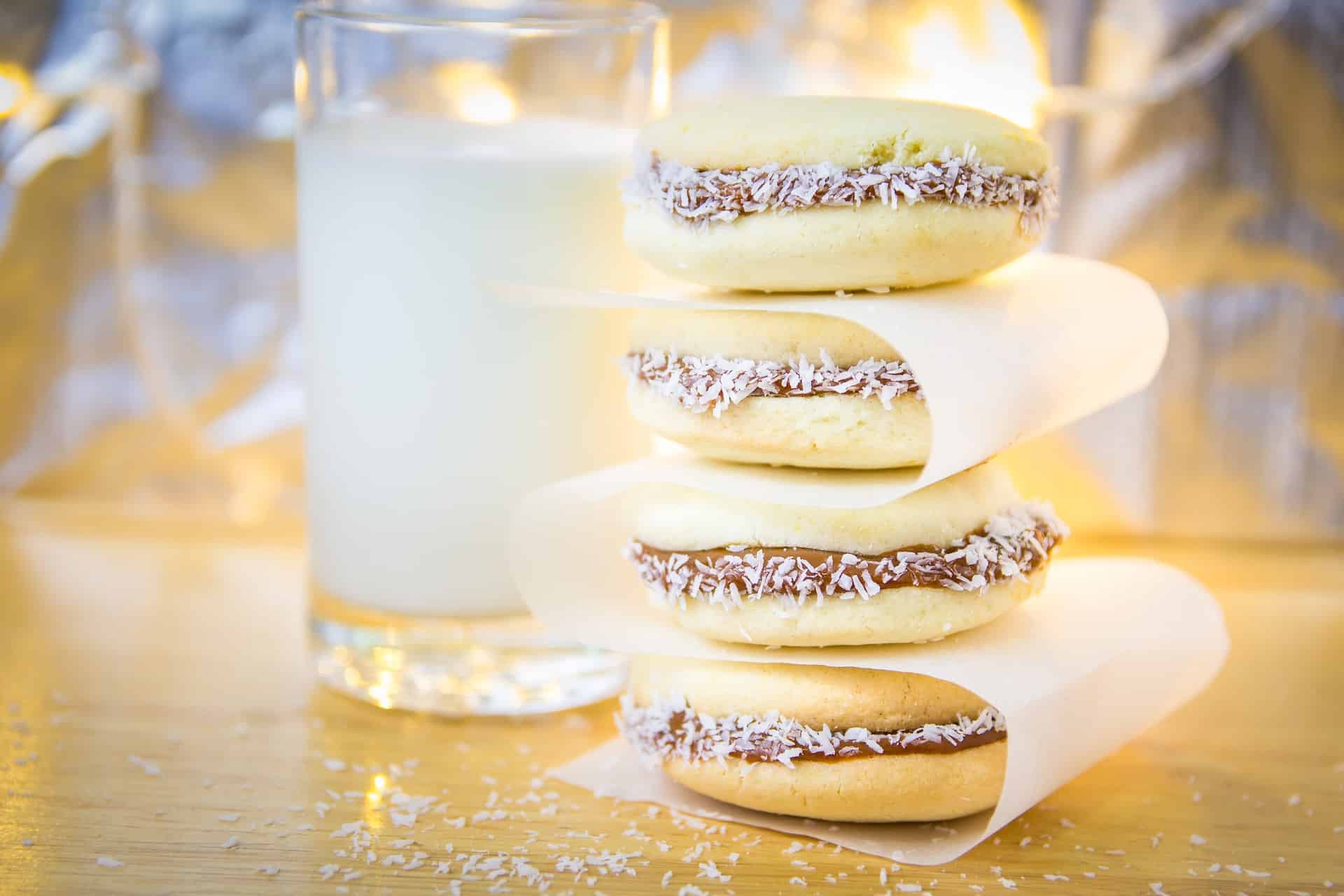


South America
Alfajores
Alfajores is a tender, filled cookie with crumbly shortbread as the exterior. On the inside, you’ll find a sweet layer of dulce de leche, which is a caramel-like candy made by gently cooking sweetened milk until it turns into a rich yet mellow treat.
Latin America
Flan
This Latin American Flan is loved by everyone including the North Americans. The Flan is made with a syrupy sauce at the base, while a very thin layer of dark caramel tops it. It’s a very simple dessert but very delicious and can be consumed right after a heavy meal.
As we traverse the globe one dessert at a time, it becomes apparent that these sweet creations are more than just culinary offerings; they are embodiments of culture, tradition, and the human desire for a touch of sweetness in life. From the delicate French pastries that grace patisserie windows to the vibrant, syrup-soaked treats of the Middle East’s bustling markets, and the intricately crafted confections of Asia’s diverse landscapes, desserts serve as a universal language of delight.
LET US HELP YOU FIND THE BEST AND LATEST DESSERTS AROUND THE WORLD.
REACH OUT TO US AT +603 2303 9100
OR [email protected]
You may also be interested in:
- Here’s why you should reconnect with nature at Club Med Bali before the year ends
- Unwind in luxury: Discover the best villa destinations around the globe
- 9 best luxury trains for an opulent adventure on rails in Asia and Europe
- Western Australia travel guide 2023: exciting destinations and things to do
